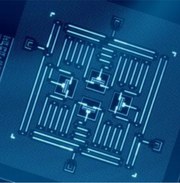Transmon
In quantum computing, and more specifically in superconducting quantum computing, a transmon is a type of superconducting charge qubit designed to have reduced sensitivity to charge noise.
The transmon was developed by Robert J. Schoelkopf, Michel Devoret, Steven M. Girvin, and their colleagues at Yale University in 2007.
[1][2] Its name is an abbreviation of the term transmission line shunted plasma oscillation qubit; one which consists of a Cooper-pair box "where the two superconductors are also [capacitively] shunted in order to decrease the sensitivity to charge noise, while maintaining a sufficient anharmonicity for selective qubit control".
[3] The transmon achieves its reduced sensitivity to charge noise by significantly increasing the ratio of the Josephson energy to the charging energy.
The result is energy level spacings that are approximately independent of offset charge.
[5] Recent work has shown significantly improved T1 times as long as 95 μs by replacing the superconducting transmission line cavity with a three-dimensional superconducting cavity,[6][7] and by replacing niobium with tantalum in the transmon device, T1 is further improved up to 0.3 ms.[8] These results demonstrate that previous T1 times were not limited by Josephson junction losses.
Understanding the fundamental limits on the coherence time in superconducting qubits such as the transmon is an active area of research.
is the charging energy inversely proportional to the total capacitance of the qubit circuit.
for typical Cooper-pair-box qubits), which is achieved by shunting the Josephson junction with an additional large capacitor.
This complication is overcome by complex microwave pulse design, that takes into account the higher energy levels, and prohibits their excitation by destructive interference.
The significant gain in the coherence time outweigh the decrease in the anharmonicity for controlling the states with high fidelity.
Measurement, control and coupling of transmons is performed by means of microwave resonators with techniques from circuit quantum electrodynamics also applicable to other superconducting qubits.
For example, in IBM Quantum Experience devices, the resonators are implemented with "quarter wave" coplanar waveguides with maximal field at the signal-ground short at the waveguide end; thus every IBM transmon qubit has a long resonator "tail".
The initial proposal included similar transmission line resonators coupled to every transmon, becoming a part of the name.
regime, coupled to different kinds of microwave cavities are referred to as transmons as well.
Transmons have been explored for use as d-dimensional qudits via the additional energy levels that naturally occur above the qubit subspace (the lowest two states).
For example, the lowest three levels can be used to make a transmon qutrit; in the early 2020s, researchers have reported realizations of single-qutrit quantum gates on transmons[10][11] as well as two-qutrit entangling gates.
[12] Entangling gates on transmons have also been explored theoretically and in simulations for the general case of qudits of arbitrary d.[13]








